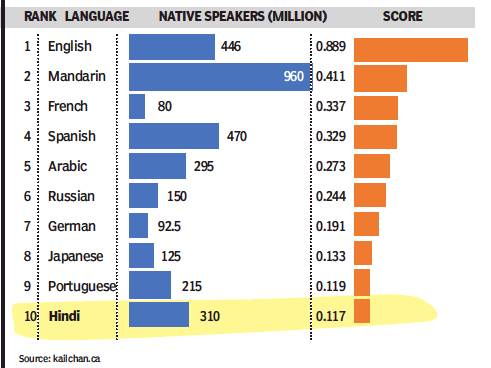Hindi language, the spread of
(Created page with "{| class="wikitable" |- |colspan="0"|<div style="font-size:100%"> This is a collection of articles archived for the excellence of their content.<br/> Additional information ma...") |
|||
| Line 9: | Line 9: | ||
[[Category:India |H ]] | [[Category:India |H ]] | ||
[[Category:Languages-Scripts |H ]] | [[Category:Languages-Scripts |H ]] | ||
| + | |||
| + | =Global power= | ||
| + | ==No. 10 in 2018== | ||
| + | [https://epaper.timesgroup.com/Olive/ODN/TimesOfIndia/shared/ShowArticle.aspx?doc=TOIDEL%2F2018%2F12%2F02&entity=Ar02016&sk=717A44AA&mode=text December 2, 2018: ''The Times of India''] | ||
| + | |||
| + | [[File: Power Language Index, 2018- Hindi was the 10 most ‘powerful’ language in the world.jpg|Power Language Index, 2018: Hindi was the 10 most ‘powerful’ language in the world <br/> From: [https://epaper.timesgroup.com/Olive/ODN/TimesOfIndia/shared/ShowArticle.aspx?doc=TOIDEL%2F2018%2F12%2F02&entity=Ar02016&sk=717A44AA&mode=text December 2, 2018: ''The Times of India'']|frame|500px]] | ||
| + | |||
| + | |||
| + | '''7,000 Estimated number of captive tigers — pets and zoo animals — in the US. It’s roughly double the world’s wild tiger population''' | ||
| + | |||
| + | English is world’s most powerful language, movies help Hindi finish at 10th place | ||
| + | |||
| + | How do we decide which is the world’s most powerful language? Should we go by the number of native speakers, or a language’s role in the global economy? Why not consider the geographical area over which a language is spoken, or its usefulness in diplomacy? But none of these parameters is enough by itself. So, Kai L Chan, a distinguished fellow at the French business school Insead, has developed a ‘Power Language Index’ that weighs each language’s influence over geography, economy, communication, knowledge & media, and diplomacy. | ||
| + | |||
| + | All things considered, English finishes first with a weighted score of 0.889 (out of 1), topping all five categories even though it has the third highest number of native speakers. Mandarin is a distant second. Hindi finishes 10th overall, but is second in the ‘knowledge & media’ category because of the large number of Hindi films made. | ||
=Tamil Nadu= | =Tamil Nadu= | ||
Revision as of 13:46, 24 December 2018
This is a collection of articles archived for the excellence of their content. |
Contents |
Global power
No. 10 in 2018
December 2, 2018: The Times of India

From: December 2, 2018: The Times of India
7,000 Estimated number of captive tigers — pets and zoo animals — in the US. It’s roughly double the world’s wild tiger population
English is world’s most powerful language, movies help Hindi finish at 10th place
How do we decide which is the world’s most powerful language? Should we go by the number of native speakers, or a language’s role in the global economy? Why not consider the geographical area over which a language is spoken, or its usefulness in diplomacy? But none of these parameters is enough by itself. So, Kai L Chan, a distinguished fellow at the French business school Insead, has developed a ‘Power Language Index’ that weighs each language’s influence over geography, economy, communication, knowledge & media, and diplomacy.
All things considered, English finishes first with a weighted score of 0.889 (out of 1), topping all five categories even though it has the third highest number of native speakers. Mandarin is a distant second. Hindi finishes 10th overall, but is second in the ‘knowledge & media’ category because of the large number of Hindi films made.
Tamil Nadu
2001-11, increase in speakers: South: 13%; TN: 50%; decline among Kannadigas
Tamil Nadu, which has long opposed the “imposition” of Hindi in the state, saw a rise of 50% Hindi speaker among Tamilians between 2001 and 2011, according to the latest census data. Overall, the percentage of Hindispeaking south Indians, however, rose by only 13% during the same period, and even declined among Kannadigas.
The anti-Hindi agitation of the 1960s led to several generations of Tamilians not learning the language. Things have changed with large scale migration of people from India’s north, north-east and northwest as blue collar and white collar workers.
“The absolute number of Tamilians speaking Hindi might be small. But given the current preference for CBSE and ICSE schools, more students could be opting for Hindi as second and third language. Also those looking for jobs outside Tamil Nadu may be learning Hindi,” said international population expert P Arokiasamy.
“There are several reasons for Tamilians learning Hindi. Migration is one, but TV programmes also influence Tamil people. The shift started when the Ramayana and the Mahabharata were telecast,” said sociologist G S Karanth.
All Tamilians speaking Hindi are not conversant with the language; many mix a bit of Tamil, English and Hindi and are able to convey what they want to say. “An autorickshaw driver may not be a Hindi pundit but if he can convey to his passenger in broken Hindi the charge for the ride, the route etc., the work is done. Thus learning Hindi also means increasing a person’s income in changed circumstances,” said Karanth. “Many company bosses are from the north and they only speak Hindi. Unless you learn Hindi, it will be difficult to work under them,” he said.
See also
Central Board of Secondary Education (CBSE)
Hindi language, the spread of